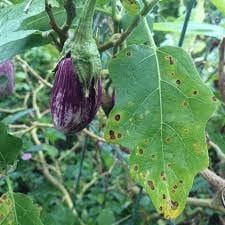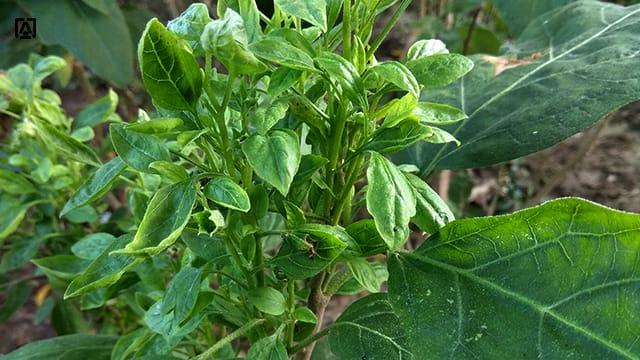Eggplant
Eggplants are annuals, 18-48 inches tall, and frost-sensitive. They prefer well-drained, loamy soil in full sun. Keep the soil moist. Eggplants are edible but not medicinal.
Habit
Annual
Height
0.5-1.5 m
Growth
Fast
Soil
Well Drained, Loamy
Shade
Full Sun
Moisture
Moist
Edible
Yes
Medicinal
No
Origin
India
Climatic Condition
Tropical
Temperature (°)
20-30°C
Humidity (%)
50-70%
Potting media
Garden soil
Fertilizers
Organic compost
Watering
Water regularly; prefers moist soil
Plant Weight
0.2-0.5 kg
Flowering Time
Summer to Fall
Soil Ph level
6.0 - 7.0
Water Ph level
6.0 - 7.0
Soil EC
0.5 - 0.8
Yield Per Plant
Marketable yield of 3.16–4.35 kilograms
NPK ratio
10:10:10
life Span
Annual
Health Benefits
Edible fruit; high in vitamins
Suggested Grow Media or Potting Mix ?
40% compost, 30% perlite, 30% peat moss
Suggested Fertigation/Fertilizers
Fertilize every 2 weeks with a balanced, water-soluble fertilizer.
Common Diseases and Remedies
| Little Leaf , Bacterial Wilt , Blight. |
No Flowering ,Sudden Wilting ,Damping Off.
Remove Solanaceous weeds, B.C. Erwinia spp , Green Manuring.
What Is A Brinjal Plant ?
A brinjal plant is another name for an eggplant plant. It belongs to the Solanaceae family and produces the fruit known as eggplant or aubergine. Brinjal plants typically have large, broad leaves and bear elongated or round fruits in various colors, such as purple, white, or green, depending on the variety. The fruit is harvested for culinary use, offering a range of culinary possibilities due to its mild flavor and ability to absorb other flavors during cooking It is native to the Indian subcontinent and is cultivated worldwide for its edible fruit. Brinjal plants are usually annuals or short-lived perennials with large, coarse leaves and prickly stems.

What are the different types of eggplant?
1. Black Beauty:-
This is a classic variety known for its large, glossy, dark purple fruits. It's widely grown and favored for its rich flavor and versatile culinary uses.
2. Japanese Eggplant:-
These are slender and elongated, typically with a deep purple skin. They have a mild, slightly sweet flavor and a tender texture, making them popular in Asian cuisine, especially for stir-fries and grilling.
3. Fairy Tale Eggplant:-
Characterized by small, striped fruits resembling miniature eggplants. They have a delicate flavor and tender texture, often used in dishes where their small size and attractive appearance are desirable.
4. Rosa Bianca:-
This variety features round to teardrop-shaped fruits with creamy-white flesh and lavender streaks on the skin. They have a mild, sweet flavor and a tender texture, making them ideal for grilling, roasting, or sautéing.
5. Long Purple:-
As the name suggests, these eggplants are long and slender, with dark purple skin. They have a slightly bitter taste compared to other varieties but are still popular for their meaty texture and ability to absorb flavors in dishes like curries and stews.
6. Indian Eggplant (Desi Eggplant):-
These are small to medium-sized eggplants commonly used in Indian cuisine. They come in various shapes and colors, ranging from round to oval and from purple to green or white. They have a slightly bitter taste and firm texture, often used in curries, stews, and pickles.

How to care for eggplant?
1.Location:
Eggplant, also known as eggplant, grows in warm climates and requires plenty of sunlight. Therefore, it should be planted in a place where it receives sufficient sunlight for at least 6-8 hours a day. Also, choose a location with well-drained soil that is rich in organic matter. Eggplants are also sensitive to cold. Therefore, do not plant in areas susceptible to frost or cold winds. Ideally, plant in a sheltered location, protected from strong winds that can damage the plant and reduce fruit production. Overall, the best location for eggplant plants is a sunny, sheltered spot with fertile, well-drained soil.
2.Soil:
Eggplants, also known as eggplants, prefer well-drained soil that is rich in organic matter. Ideally, the soil should be loamy and slightly acidic to neutral, with a pH of 6.0 to 7.0. This type of soil structure allows for proper root development and nutrient uptake while preventing waterlogging that can cause root rot.
Before planting eggplants, amend the soil with organic materials such as compost, old manure, and leaf mold to improve fertility and texture. This helps retain moisture and nutrients while promoting the activity of beneficial microorganisms within the soil.
3.Hydration:
Hydration is crucial for brinjal plants, as they require consistent moisture to thrive and produce healthy fruits. Here are some guidelines for watering brinjal plants , Keep the soil consistently moist, but not waterlogged. Aim to water the plants deeply, ensuring that the water penetrates the root zone. Avoid letting the soil dry out completely between waterings, as this can stress the plants and affect fruit development. Water brinjal plants regularly, especially during hot and dry periods. Depending on factors such as temperature, humidity, and soil drainage, you may need to water every 2-3 days or more frequently if conditions are particularly dry.

5.Nourishment:
To nourish brinjal plants and promote healthy growth and fruit production, it's essential to provide them with adequate nutrients. Apply a balanced fertilizer formulated for vegetables, with a higher potassium and phosphorus content (such as 5-10-10 or 10-10-10), to provide essential nutrients for brinjal plants. Follow the manufacturer's instructions for application rates and frequency, typically fertilizing every 4-6 weeks during the growing season. Incorporate organic matter into the soil before planting, such as compost, aged manure, or composted leaves. Organic matter improves soil structure, fertility, and microbial activity, providing a steady supply of nutrients to brinjal plants as they grow. Apply a layer of organic mulch, such as straw, shredded leaves, or compost, around the base of brinjal plants. Mulch helps conserve soil moisture, suppress weeds, and gradually release nutrients into the soil as it decomposes, nourishing the plants over time.
6. Issues:
Brinjal plants are susceptible to pests such as aphids, flea beetles, spider mites, and fruit borers. These pests can damage foliage, transmit diseases, and reduce fruit quality and yield. Regular monitoring and appropriate pest management strategies, such as using insecticidal soaps, neem oil, or biological controls, can help mitigate pest damage. Brinjal plants are vulnerable to various fungal, bacterial, and viral diseases, including early blight, powdery mildew, bacterial wilt, and mosaic virus. Symptoms may include leaf spots, wilting, stunted growth, and fruit rot. Proper sanitation, crop rotation, and disease-resistant varieties can help prevent and manage diseases in brinjal plants. Environmental factors such as temperature extremes, drought, and waterlogging can stress brinjal plants and affect their growth and productivity. Providing adequate irrigation, mulching, and shading during hot weather can help mitigate environmental stress and maintain plant health.
What are the benefits of the eggplant?
Rich in Nutrients
Heart Health
Weight Management
Blood Sugar Control
Skin Health

FAQS about growing brinjal plant
1.What are some culinary uses for brinjal, and how is it typically prepared in different cuisines?
1. Indian Cuisine: Brinjal is a staple in Indian cuisine and is used in various dishes such as Baingan Bharta (smoky roasted eggplant curry), Baingan Ka Bharta (mashed eggplant curry), Baingan Masala (spiced eggplant curry), and Aloo Baingan (potato and eggplant curry). Brinjal is also commonly used in pickles, chutneys, and snacks like pakoras (fritters).
2. Mediterranean Cuisine: In Mediterranean cuisine, brinjal is often used to make dishes like Moussaka (layered eggplant casserole with minced meat and béchamel sauce), Baba Ganoush (smoky roasted eggplant dip), and Caponata (Sicilian eggplant relish). Grilled or roasted eggplant slices are also served as a side dish or appetizer.
3. Middle Eastern Cuisine: Brinjal is a key ingredient in Middle Eastern dishes such as Mutabbal (similar to Baba Ganoush), Mahshi (stuffed eggplant), and Maqluba (layered rice and eggplant dish). Brinjal is often grilled, roasted, or fried and served with yogurt, tahini, or pomegranate molasses.
4. Asian Cuisine: In Asian cuisines like Chinese, Thai, and Japanese, brinjal is used in stir-fries, curries, soups, and noodle dishes. Some popular dishes include Szechuan Eggplant (spicy Chinese stir-fry), Thai Green Curry with Eggplant, and Japanese Nasu Dengaku (miso-glazed grilled eggplant).
2. What are the ideal growing conditions for brinjal plants?
The ideal growing conditions for brinjal plants include:
Sunlight , Temperature ,Soil , Watering , Spacing, Support , Fertilisation. By providing brinjal plants with the ideal growing conditions of sunlight, temperature, soil, water, spacing, support, and fertilisation, you can help ensure their health and productivity, resulting in a bountiful harvest of delicious eggplants.
3.Can you provide tips for harvesting and storing brinjal fruits to maximize freshness and flavor?
Certainly! Here are some tips for harvesting and storing brinjal (eggplant) fruits to maximize freshness and flavor , 1. Harvesting Time , Timing Handle, Carefully , Storage Temperature, Use Promptly , Check Regularly, Avoid washing .
4.Are there any special considerations or techniques for growing brinjal plants organically or in containers?
Yes, there are special considerations and techniques for growing brinjal plants organically or in containers. Here are some tips: Soil , Container Size , Location , Watering, Fertilisation, Support, Pest and Disease Management, Mulching.
5.How does brinjal cultivation contribute to sustainable agriculture and food security?
Brinjal cultivation can contribute to sustainable agriculture and food security in several ways:
1. Crop Diversity
2. Resource Efficiency
3. Nutritional Value
4. Income Generation
5. Adaptation to Climate Change
6. Reduced Food Waste
7. Genetic Diversity Conservation




